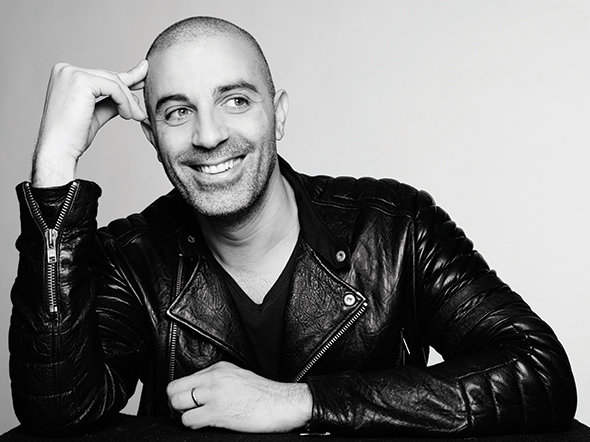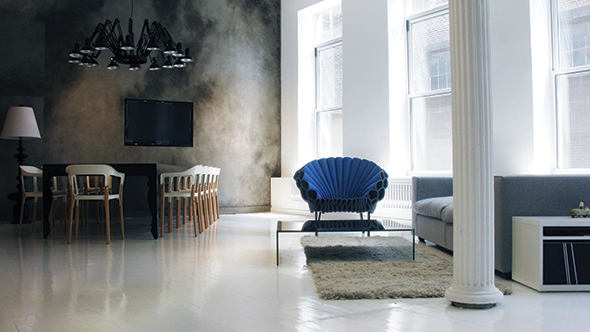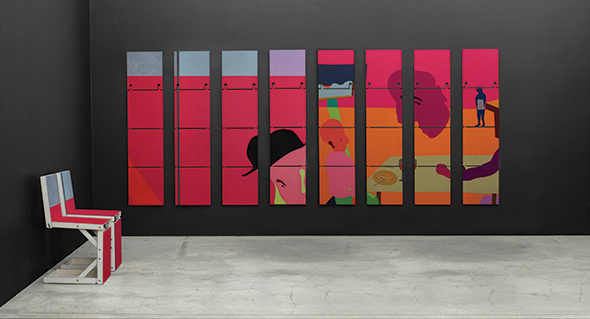
Scene: Rihanna writhing suggestively, clad in pink latex singing about the fantasy of every man and woman. Zoom in: beyond the overt sexuality, beyond the skin, beyond the lyrics of the hit song “S&M,” you will find a chair as curvaceous and unique as the singer herself. Enter the Peacock Chair by Dror. The ‘holistic’ design firm, headed by Dror Benshetrit, creates transformative products and plans that aren’t made for fame, but are so innovative that they earn it, even on a pop-star level. From one of a kind, multi faceted everyday products that are as revolutionary as they are beautiful to world-changing partnerships with progressive cities and businesses, Benshetrit is taking over the design world one dream at a time.
Back to the Peacock Chair, for there is more than meets the eye, and it is surely worth further investigation. According to Benshetrit, the chair was created out of a break up and through the marriage of opposites. The contradictions that often cause inner turmoil – right or wrong, safety or vulnerability – are animated in the peacock. Known for its beauty, the peacock spreads its tail feathers for two reasons: to scare away and to attract. “This is fascinating for me, and it’s the place I wanted to work from,” muses the designer. “How to create furniture that has that type of duality? The material [of the chair] has no structural integrity, but can hold the person only by the fold. Four circles of felt on a minimal metal frame.” The chair is now a part of the Metropolitan Museum of Art’s permanent collection.

“There are a few ways things are born,” states Benshetrit. “One – things I feel I need to create. Two – the things we feel we need to fix, that we care about, that we project will solve a kind of problem. And, three – you get a brief from an office and they have a challenge that they need you to fix.” Dror’s Pick Chair was created out of the second reason – something Benshetrit felt he needed to fix. As he very clearly explains, we entertain people in our homes all the time, but since many of us live in small spaces, we have seating that is inconveniently stored away and too ugly to keep out permanently. The Pick Chair is functional art. It can be hung flat on the wall as a decorative piece, and then taken down and folded into a chair when the occasion arises. Dror’s work is never a race of function before form, but rather a balance of the two. Benshetrit laughs at the irony of this piece, since instead of hiding it away, he’s inviting his guests to sit on something he is proud of – to literally sit on his art.
Transformation, a theme that is constant in the firm’s work – small to capacious – shows itself in different guises. The peacock chair emulates the transformation between opposites; the pick chair transforms literally from art to furniture; and the backpack they created for Tumi is comfortable on the go, but sleek for the office. The larger projects that the firm takes on also go through their own transformation, all while changing the space they consume. It’s even in their tagline- “ideas for change.” Benshetrit candidly admits that the timeline for each project can vary drastically. “There are averages to product timelines. Creation is like poetry. It can happen overnight or it can take twenty years. There are ideas that are very quick to materialize and there are ideas I’ll be pushing for the rest of my life.”
Just as his projects grow organically, so has his business. “I started with me, myself, and I,” reminisces Benshetrit. As his work garnered attention, internship offers came in, and so began the growth pattern. “We can’t predict what we will be doing in ten years… Sometimes it’s really about constantly listening to the movements of the world.”

“We are extremely particular about projects that we take. We always work on projects we’re extremely passionate about.” Benshetrit’s enthusiasm for his business is contagious. He lists off some of his favorites (though, like parents, they are very proud of all of them), and explains that ultimately, the process is what is most memorable. Some clients push them out of their comfort zones, while sometimes his company pushes the clients. One project he is particularly proud of is QuaDror, which is categorized as one of the medium- to large-scale projects. QuaDror was a product of the designer’s own ponderings, and could possibly revolutionize the building blocks of the future. Another large-scale product that the designer is fond of is Nurai Island, which borrows from Persian rugs to create an island that offers both community and privacy off the coast of Abu Dhabi. Nurai Island is now completed and features twenty-four villas and a sprinkling of residences integrated into the green vegetation ‘carpet’ of the island.
What does the future hold for Dror? A little bit of everything, it seems. “As a design practice we constantly think of innovation and are re-thinking experiences.” reflects Benshetrit. “One thing we’re constantly doing is rethinking the model of design practice. I do feel that we’re going to make a lot of new ways of working with brands. We see tremendous entrepreneurial movement.” Amongst their many projects, Studio Dror is developing an ‘arm’ which will incubate ideas and bring them to the market in a different way than just giving service to companies. They also have a project lined up that’s bound to change the way we use light. And, on a larger scale, they have been in talks with NASA for a project to help protect the world from climate change, which comes at a very tumultuous, but opportune, time.
It appears that Dror, and Benshetrit himself, will not be stopping anytime soon – or at least as long as there are problems to be solved and designs to be dreamed.
Text by Leah Tassinari

